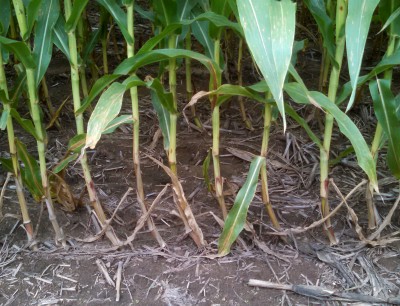The 2014 crop season had its fair share of severe weather across southwest Michigan. Heavy thunderstorm winds in combination with driving rainfall caused severe lodging in many corn fields in the southern two tiers of counties across Michigan in both the mid- and later vegetative growth stages.

Goosenecked corn stalks.
While nearly every field that was impacted by these storms was able to get the crop growing in the right direction again, there is a good possibility that these fields will be susceptible to lodging if windy weather becomes a challenge this harvest season. Many of the plants have large, curving “goosenecks” just above the root-line. They are also supporting some pretty nice ears, thanks to the favorable growing conditions we saw this season.
One of things Michigan State University Extension recommends growers can do while we are waiting for a return to dry weather is to get out and evaluate their fields for stalk strength, particularly fields that have significant goosenecked stalks. The test is pretty simple. Walk down some random rows and push on a significant number of plants and see how many of the plants fall over. Growers should look at a significant number of plants in several locations of the field to be able to calculate a percentage of stalks that are prone to lodging.
Goosenecked stalks are not the only potential issue impacting stalk strength out in the fields this fall. Leaf diseases, particularly gray leaf spot and northern corn leaf blight, were fairly common in fields across the region in 2014. We also had a tremendous amount of fields that exhibited nitrogen deficiency symptoms due to leaching or denitrification losses of nitrogen across the region this year. Both of these conditions can lead to excess scavenging of carbohydrates from the stalks to provide for the developing kernels.
Anytime this happens there is a good chance that stalk strength will be compromised, and in either case, a simple push on the plants about ear height can help growers to determine the stalks ability to withstand wind. Knowing stalk strength can help producers to prioritize fields that need to be harvested earlier rather than later.





